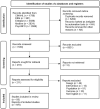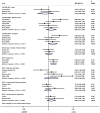Do ASD and ADHD Have Distinct Executive Function Deficits? A Systematic Review and Meta-Analysis of Direct Comparison Studies
- PMID: 37565325
- PMCID: PMC10637091
- DOI: 10.1177/10870547231190494
Do ASD and ADHD Have Distinct Executive Function Deficits? A Systematic Review and Meta-Analysis of Direct Comparison Studies
Abstract
Objective: To evaluate if children and adolescents with a diagnosis of ASD or ADHD have distinct executive function (EF) profiles.
Methods: Peer-reviewed articles comparing ASD, ADHD, and typically developing individuals under 19 years of age were identified. The domains evaluated were: working memory, response inhibition, planning, cognitive flexibility, attention, processing speed, and visuospatial abilities.
Results: Fifty-eight articles met inclusion criteria. Analyses were performed on 45 performance metrics from 24 individual tasks. No differences in EF were found between individuals diagnosed with ASD and ADHD. Individuals diagnosed with ASD and ADHD exhibited worse performance in attention, flexibility, visuospatial abilities, working memory, processing speed, and response inhibition than typically developing individuals. Groups did not differ in planning abilities.
Conclusion: Children and adolescents with ASD and ADHD have similar EF profiles. Further research is needed to determine if comorbidity accounts for the commonality in executive dysfunction between each disorder.
Keywords: ADHD; adolescence; autism spectrum disorders (ASD); children; executive function.
Conflict of interest statement
Declaration of Conflicting InterestsThe author(s) declared no potential conflicts of interest with respect to the research, authorship, and/or publication of this article.
Figures




References
-
- American Psychiatric Association. (2013). Diagnostic and statistical manual of mental disorders (5th ed.). 10.1176/appi.books.9780890425596 - DOI
Publication types
MeSH terms
Grants and funding
LinkOut - more resources
Full Text Sources
Medical
Miscellaneous

